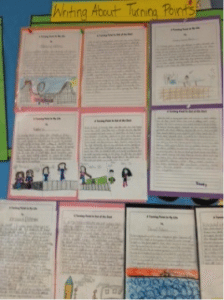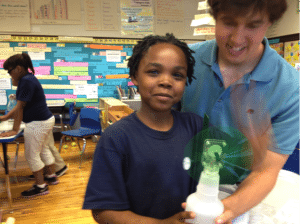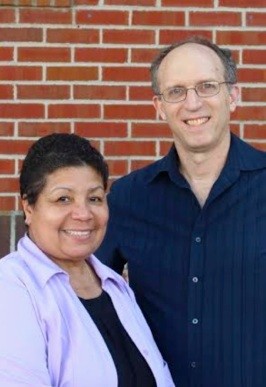This post is the last in a series of guest blogs by Robert Welch on how he utilizes the Question Formulation Technique (QFT) in his curriculum around the novel Out of the Dust. To see his previous blogs click here.
Ultimately , students left their experiences reading and discussing Out of the Dust with a good of understanding of the book. On two comprehension tests, one multiple choice and the other short response, the class averaged scores of 79% and 80% respectively. This is notable because Out of the Dust’s grade level equivalence is 5.1 according to Scholastic, and the majority of the class was third grade students.
Students also left the book with deep and subtle appreciation for its message and plot elements. For example, when asked on the short response comprehension test: “Would you recommend this book to others to read?”, Vianey wrote: “Yes, I would. This book shows you can forgive people. It shows you how to deal with problems in life.”
This greater depth of understanding of the story’s theme/message was also evident in the written work students produced. After posing and researching ideas to what caused Billie Jo’s turning point at the climax of Out of the Dust, students wrote essays on turning points (in Out of the Dust and their lives) that beautifully exemplified their understanding of how integral a turning point can be to a story’s plot, and to someone’s life.
What struck me about the essays was how expressive they were about the causes and effects of turning points in their lives and in the main character’s. Nyrissa wrote: “A turning point is when you change or grow because of an event. I had a turning point when I was in second grade. First, I was mean and didn’t like nobody in my class. And I was bossing people around. But then I changed because I saw that it hurt people in the inside and out. So I stopped it, and I was being nice and I have a lot of friends now…This changed me because if I stayed mean I couldn’t have any friends…And I found myself in a new way. Like, I could be better. And mostly be nice about everything and every one.”
Of course, teaching students the QFT was not solely responsible for the reflectiveness in students’ essays; there were activities that helped them activate their prior knowledge about turning points and connect them to the protagonist’s in Out of the Dust. However, I do think that the QFT process did open up students to be inquisitive, reflective thinkers, and these characteristics permeated into how students approached learning in any content area or aspect of school. In my teaching journal one entry (3/6/13) notes:
I’ve started to notice that my kids ask a ton of questions. Like, more than classes I’ve had in the past. Today we were watching March of the Penguins as a way to relax after a morning of stressful ISAT. And my kids, especially Lamar, Evan, Daquan, Tyteonnah, and Darryl, kept raising their hands as we watched.
On the final survey, when asked: “Has learning how to ask and answer deep questions helped you become a better learner and thinker?” students unanimously answered “yes”. Below is a table with selected student explanations of why they said “yes” to the previously mentioned question. I believe that their responses do a nice job illuminating how the QFT has improved their learning in my classroom.
The QFT made me… A better reader: “Now I can understand books” –Tyteonnah “I wasn’t good at reading and now that the deep questions help me I can do it” –Ana “I’m able to think on the book we are reading” –Ciara “I think deeper and I think more about my books” –Daquan A better learner: “I can learn so much more with deep questions” –DJ “It makes me think about the thing and I’m learning more” –Lamar A smarter and more knowledgeable person: “When somebody ask deep questions and you will be able to answer it and you will feel smart that way” –Latrae “It’s a smart thing and it makes you learn a lot” –King A collaborative learner: “My group get me more thinking” –Tiana A deeper thinker: “When you ask questions it makes you think” –Tim “Before you give your answer or thought you have to really think about it. And it made me a better thinker and learner because the questions that people have are very hard so you learn from them and you have to think through in order to have the right answer for them” –Niassa
As we move into the Common Core era, and the focus in classrooms shifts towards rigor, depth, and challenge, the Question Formulation Technique will be ever more valuable. In order to meet the goals of the Common Core, we will need to leverage students’ natural curiosity into rich and meaningful discussion, research, and collaborative projects. The Question Formulation Technique is just such a tool. It was integral in establishing a vibrant culture of learning in my classroom and nurturing that seed of inquiry in each of my students. The process of using it helped teach me that with the right scaffolds, students can approach learning with a passion and autonomy that I hadn’t known before.
References
Chin, C., & Osborne, J. (2008). Students’ questions: a potential resource for teaching and learning science. Studies in Science Education, 44(1), 1-39. doi: 10.1080/03057260701828101
Mazzola, A. (2009). My Inquiry Journey: A Field Guide for Learners. Knowledge Quest, 38(1), 40-47.
Rothstein, D., & Santana, L. Make Just One Change: Teach Students to Ask Their Own Questions. Cambridge: Harvard Education Press, 2011. Print.
Note that students’ names have been changed.






Speak Your Mind